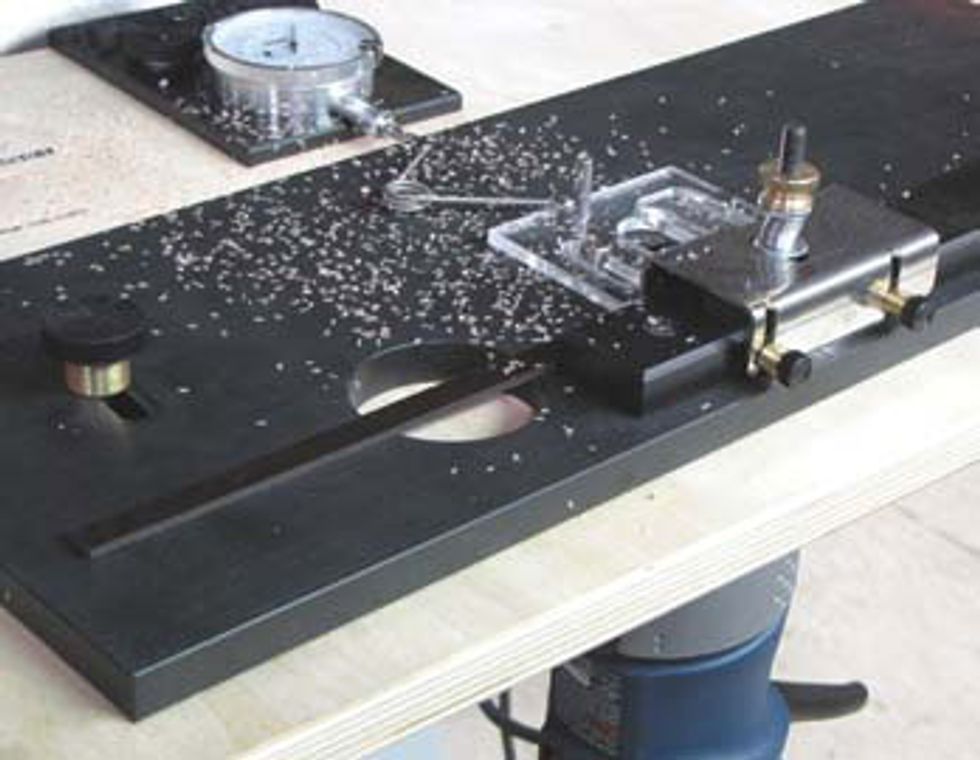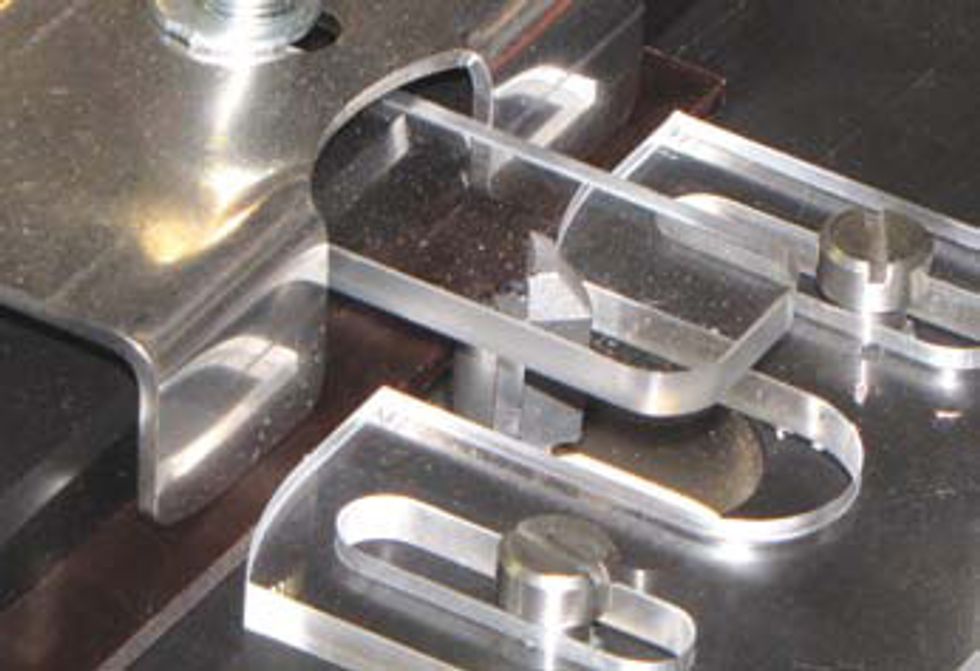 A MacRostie Binding Trimmer in action. |
 A close-up of the MacRostie router bit. |
Welcome to a front-row seat at PG’s
Restoring an Original column. We’re back
at it and moving forward with replacing the
decayed binding on a 1974 Gibson J-50
Deluxe. Last month we talked about how this
was not your classic case of celluloid binding
shrinkage and that we were dealing with
original tortoise binding, which seems to find
a way to self-destruct over time as the plastic
binders—substances that cause mixture components
to cohere—start to age.
The neck is off because it was originally
scheduled for a reset, so this is the perfect
opportunity to remove and replace the top
and back body binding. I used a hair dryer,
a Channel Spatula, a Sloane Purfling Cutter
(item number 0354 from Stewart-MacDonald,
stewmac.com), and a ShopStand and Guitar
Repair Vise (item number 5391) for the
removal. As I began removing the binding,
I knew it was important to do so in a controlled
manner. Remember that the body was
not going to be stripped and fully re-sprayed.
I was planning to keep things looking really
clean and crisp, because I knew there would
only be a thin layer of nitrocellulose airbrushed
over the replaced binding once
everything was trimmed and groomed.
The Faux-Tortoise Treasure Hunt
It wasn’t as easy as I thought it would be to
find .100" x .275" celluloid nitrate binding of
the faux tortoise variety. I made lots of calls
and heard a lot of “I don’t think you’re going
to find any,” “Sorry, that’s all we carry,” or
“It doesn’t exist in the United States.” So I
set out on a quest to find at least one strip
of this rare material. Clearly, I just hadn’t
contacted the right people. The next company
I contacted was Stewart-MacDonald. I
knew from going through their catalog that
they didn’t stock tortoise binding in the size
I needed—nor did anyone else that I knew
to contact—but I had high hopes that they’d
know who would. They responded quickly:
“Axiom Inc.” It was ironic, too, because there
I was, searching everywhere, preparing to
search overseas, and then I found Axiom
Inc.—almost literally in my backyard here in
Minnesota. Axiom’s website (axinc.net) lists
an assortment of tortoise sheets and binding,
along with pictures that make it very easy to
order. Booya! The binding (item CT100-375)
even arrived the next day. The height still
needed to be trimmed .100" for a perfect fit,
but that wasn’t an issue because I had the
new MacRostie Binding Trimmer.
I should note here that celluloid nitrate is
considered a hazardous material because of
its flammability, which means companies like
UPS require additional surcharges to ship it.
That’s why it’s often a good idea to order a
little extra to have in store for next time. In
this case, it was really good-looking tortoise
and something that I wanted to have on hand
in my shop at all times, so I ordered extra
and we store it in a cool, well-ventilated area
of the building.
Trimming the Binding
The MacRostie Binding Trimmer (item number
2401) was an absolute must-have for
restoring the binding on the J-50 Deluxe. It’s
very cleverly designed by Don MacRostie at
Red Diamond Mandolin, and it’s the easiest
way to custom-size wood or plastic bindings
for a perfect fit, because it precisely
duplicates the dimensions of older bindings
for repair and restoration work. Its precision
dimensioning gauge and custom adjustable
fence give you accurate, repeatable results. It
makes your bindings fit better, and it virtually
eliminates tedious scraping and sanding after
they’re glued in place.
After making various adjustments and taking
a reading from the large dial gauge on the
indicator plate, I started by trimming down
the binding in .010" increments. Luckily, the
MacRostie makes it incredibly easy to make
controlled, precision cuts—it’s like shaving
butter. (Congrats, Don—You really raised the
bar in tool design!)
To finish up the job, I lined the inside edge
of the route with .060" white/black/white
purfling (item number 1028), then wrapped
the faux-tortoiseshell binding around the outside.
This purfling worked perfectly, because
the dimensions turned out to be exactly what
the ’74 Gibson J-50 Deluxe called for.
I hope your summer is off to a wonderful
start! See you next time.
John Brown
John Brown, of Brown's Guitar Factory, is the inventor of the
Fretted/Less bass. He owns and operates a full guitar manufacturing
and repair/restoration facility, which is staffed by
a team of talented luthiers. He is also the designer of guitar-making/repair tools and accessories that are used today by
instrument builders throughout the world.











![Rig Rundown: Russian Circles’ Mike Sullivan [2025]](https://www.premierguitar.com/media-library/youtube.jpg?id=62303631&width=1245&height=700&quality=70&coordinates=0%2C0%2C0%2C0)





